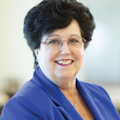For decades we have heard that the laboratory personnel shortage is coming. Today that shortage seems more evident than ever before. We have read about the main reasons contributing to the personnel shortage including the closure of laboratory training programs, increased number of retiring laboratorians, and decreased number of individuals entering our profession. Now we need to ask ourselves, “How can we be a part of the solution?” For me, it’s all about recruitment and retention.
Recruitment
How old were you when you were first asked the question, “What do you want to be when you grow up?” You may have answered actor, musician, teacher, athlete, doctor, firefighter, or even police officer. Regardless of how you answered, surely it was a career that you had knowledge of. The truth is that our profession—clinical laboratorians—has an identity crisis. We know who we are and what we do, but it’s a big secret to the general public. Don’t you think that it’s about time to let the cat out of the bag?
Never too young
Is there an age that is too young to start career exploration? Cahill and Furey’s research concluded that there is value and benefit to children as young as three to eight years old learning about potential careers.1 Pre-school and elementary school aged children identify with workers and careers in their neighborhood and community. They are curious about exploring what adults do for work. One of my favorite recruiting activities for elementary school is reading the book titled, I Had a Lab Test by Joyce McCreary, MT(ASCP). It’s fun to get dressed in scrubs with a white lab coat, gloves, and goggles as I walk into the classroom carrying a biohazard bag filled with a rainbow of vacutainer tubes and a throat culturette swab.
Middle school
More than 5 million Instagram hashtags include the word slime (#slime). It seems as if every middle school aged child loves playing with slime. This is an amazing opportunity to introduce young scientists to Hands-On Grossology by Sylvia Branzei.2 What student doesn’t want to participate in really gross science experiments? As an educator, the child in me enjoys creating simulated laboratory specimens such as blood, urine, stool, and vomitus. However, it is even more fun to watch the reaction of these students as each specimen container is opened. That’s what you call a real attention getter!
High school
Recruitment activities for high school students include partnering with STEM (Science, Technology, Engineering, and Math) education teachers, medical magnet schools, HOSA (Future Health Professionals, formerly known as Health Occupations Students of America), students, and career immersion programs. Last summer, Mayo Clinic School of Health Sciences offered a Medical Laboratory Science Career Immersion Program in Jacksonville, FL. Twelve diverse high school students spent four days immersed in Transfusion Medicine:
- Day one promoted blood donation awareness. Students were introduced to blood donor facts, including that 4.5 million Americans would die each year without life-saving blood transfusions and that donating one pint could help save three lives.
- On day two, the students toured the Department of Laboratory Medicine and Pathology. Each lab section participated and explained their valuable contribution to a patient’s diagnosis.
- Day three was spent at a local community college in the MLT student laboratory where students performed routine ABO and Rh blood typing.
- On day four, the Career Immersion Program concluded with a simulated life-saving blood transfusion.
College-aged youth
How can we get college students interested in the medical laboratory? The National Center for Education Statistics states that approximately 110,000 biological/biomedical science students graduate each year with a Bachelor of Science degree.3 This is an opportunity to invite college faculty to invest in career exploration by allowing their students to take a tour of our laboratories in lieu of completing their three hour lab class on campus. In Florida, college students majoring in microbiology are surprised to learn that they must complete a laboratory training program in order to work in a clinical microbiology lab due to state licensure. For those interested, explore the opportunity of inviting the student back to spend one day observing each of the specialty areas of the laboratory. It’s rewarding to our staff and they take pride in sharing their vital role as an integral part of the healthcare team.
Educational resources
Now that the recruitment phase was successful, let’s direct students to readily-available educational resources such as the National Accrediting Agency for Clinical Laboratory Sciences (www.naacls.org) and the American Society for Clinical Laboratory Science‘s (ASCLS) Education Scientific Assembly’s (ESA) Medical Laboratory Education Online Directory (www.ascls.org/careers-ascls/mls-programs-lists). In Florida, the Board of Clinical Laboratory Personnel lists all Florida approved training programs on the Department of Health website. It’s then up to the student to find a Medical Laboratory Science program that best fits their needs.
The Mayo Clinic School of Health Science Medical Laboratory Science Program is committed to training undergraduate and post-baccalaureate students in laboratory medicine, quality assurance, and professional practice. Our faculty members promote academic excellence, instill professionalism, and encourage the pursuit of lifelong learning. We strive to retain excellent students for employment and promotion at Mayo Clinic. Florida-appointed students enrolled in the 4+1 track of the medical science certificate program complete 12 months of didactic courses and clinical laboratory rotations within the Department of Laboratory Medicine and Pathology at Mayo Clinic. Eight months of didactic courses and clinical laboratory rotations are completed at Mayo Clinic’s campus in Rochester, Minnesota, and the remaining four months are at Mayo Clinic’s campus in Jacksonville. There are more than 3,000 laboratory positions at Mayo Clinic alone and 100 percent of our graduates find employment within three months of graduation. Our program has a three-year average placement rate of 100 percent.
Retention
Now that we have hired the new employee, how do we as managers retain them? Doig and Beck’s research on clinical laboratory personnel retention cited salary, work independence, and work appreciation as the most important factors to retaining lab staff.4,5 All laboratorians want to feel valued and appreciated. Many may think that it starts at the top, however, I would argue that it starts at the bottom with coworkers. The benefits of peer-to-peer praise leads to significantly higher levels of employee performance and engagement, as well as increased customer loyalty and retention.6 It creates a sense of teamwork within the work unit. It also motivates employees to continue doing their best even when performing routine tasks. It reduces employee turnover because coworkers feel appreciated for their hard work and extra effort. It also adds to an employee’s overall job satisfaction and loyalty to the employer. That is why many healthcare facilities invest in formalized employee recognition programs.
Employee recognition programs
You’ve heard the adage, “People leave managers, not companies,” right? A 2018 Gallup data poll revealed that the most memorable recognition comes most often from an employee’s manager.7 Their recommendation is that recognition should be given on a regular basis (weekly) and timely so the employee understands the impact of their recent achievement(s).5 The Gallup research also revealed that only one in three U.S. employees reported that they had received recognition for their work performance within the last week.7 How often do you catch your employee doing great work such as catching an error, staying late for shift coverage, or sharing a rare laboratory finding? Do you take the opportunity to thank them in real time? Do you recognize the employee again at your monthly staff meeting or team huddle?
As a manager, do you take the opportunity to share how proud you are of your staff to others within the organization? Appreciation by other healthcare professionals and hospital administrators enables the laboratory staff to feel valued. What is the culture at your institution? Do the pathologists value the medical laboratory scientists? Do they greet each other by name? Do the Department Chair, Medical Director, and Operations Administrator share their appreciation to the staff for embracing workflow changes, validating newly installed equipment, and completing successful inspections? Is staff appreciation given on a regular basis or is it only shared during National Lab Week or Employee Recognition Day? As leaders, we lead by example. It can be as simple as sending out a general email and having lab leadership reply thanking the staff for their valued contributions.
Rothenberg states that job satisfaction is tied to workload, recognition, and salary.8 Staffing to workload is a hot topic and is an institutional expectation in most healthcare institutions today. The personnel shortage leaves those on the workbench working overtime, double shifts, and with fewer staff. However, the customer’s expectation is that the same level of service will be provided, and the same high quality of lab results will be reported as if the lab is fully staffed. As a result, poor working conditions often lead to fatigue, increased error rates, and employee burnout.9
The Florida trend
It’s estimated that the number of individuals over 65 will double over the next 30 years.10 Many retirees relocate from the frozen tundra to sunny Florida. As a Floridian, it amazes me to know that there are 919 newcomers to Florida every day.11 The Florida Trend predicts that within the next five years Miami, Fort Lauderdale, and Jacksonville will each have over 1 million residents each.11 How will the demand for medical laboratory scientist keep pace with the state’s population growth? The Florida Department of Health’s Board of Clinical Laboratory Personnel reports that there are approximately 18,244 licensees; including 244 directors, 5,534 supervisors, 10,631 technologists, and 1,835 technicians.12 With estimates that there are only 10,000 MLS graduates per year in the U.S., one must ask themselves, “Has the demand now exceeded the supply in Florida?”
I’ll ask my first question again, how can we be part of the solution? For me, it’s all about recruitment and retention.
REFERENCES
1. National Center for Education Statistics. https://nces.ed.gov/. Accessed May 31, 2019.
2. Achor S. The Benefits of Peer-to-Peer Praise at Work. Harvard Business Review. 2016.
3. Beck S, Doig K. Laboratory Managers' Views on Attrition and Retention of Laboratory Personnel. Clinical Laboratory Science. 2005;18(4):238-247.
4. Branzei S. Hands-on Grossology. New York: Price Stern Sloan; 2003.
5. Cahill M, Furey E. The Early Years Career Development for Young Children A Guide for Educators.; 1994.
6. Doig K, Beck S. factors Contributing to the Retention of Clinical Laboratory Personnel. Clinical Laboratory Science. 2005;18(1):16-27.
7. Mann A, Dvorak N. Employee Recognition: Low Cost, High Impact. 2016. https://www.gallup.com/workplace/236441/employee-recognition-low-cost-high-impact.aspx. Accessed June 1, 2019.
8. Rios, M. (2014, May 6). Fueled by Aging Baby Boomers, Nation's Older Population to Nearly Double in th Next 20 Years. Retrieved from https://www.census.gov/newsroom/press-releases/2014/cb14-84.html
9. Rothenberg I. Responding to the Continuing Prsonnel Shortages in Laboratory Medicine. http://www.labtestingmatters.org/responding-to-the-continuing-personnel-shortages-in-the-lab. Accessed May 26, 2019.
10. Slagle DR. Recruitment and Retention Strategies for Hospital Laboratory Personnel In Urban and Rural Settings. Clinical Laboratory Science. 26.(1):10-14.
11. Van Siclen, C. (2019, March 15). Laws and Rules of the Board. Lecture presented at Florida Society of Clinical Laboratory Science Spring Meeting in Florida, Orlando.
12. Vogel M. 919 new Floridians every day. https://www.floridatrend.com/article/25490/919-new-floridians-every-day. Published September 27, 2018. Accessed May 26, 2019.
About the Author

Carleen Van Siclen
MS, MT (ASCP)CM, TS (ABB) serves as Manager of Laboratory Staff Education and Professional Development at Mayo Clinic in Jacksonville, Florida. Carleen has been a medical laboratory scientist for over 35 years and is board certified by the American Society for Clinical Pathologists (ASCP) and the American Board of Bioanalysis (ABB).
